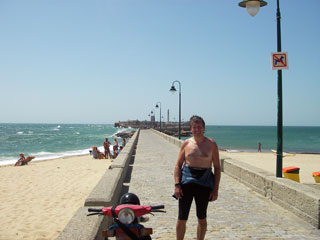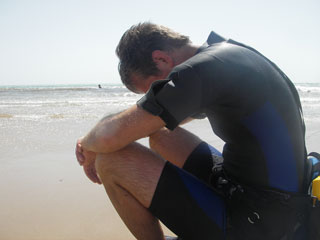
Between 1999 and 2006, Tom Naylor and Christopher Gibson have spent most of their summer holidays circumnavigating Europe on their windsurfers. Departing from Christopher's home on Hayling Island, England, UK they windsurfed over five summer holidays, they windsuirfed to Africa, picking up each morning where they left off the day before, till the holiday ran out, and then the next year continuing again
| Day: | 2006 - 7 |
| Date: | Thursday 7th August |
| Depart: | Camping Tarifa |
| Latitude: | 36.05271 |
| Longitude: | -5.65120 |
| Stop: | Morocco |
| Latitude: | 35.90600 |
| Longitude: | -5.47505 |
| Arrive: | La Linea / Gibraltar |
| Latitude: | 36.15660 |
| Longitude: | -5.33821 |
2006 Day 4: Beating the Levante: 19 miles Posted On: 31/08/2006 13:08:45 | |
 | |
Another morning, another light offshore air. We began readying ourselves and our kit for launch. This is not an instant process. It usually takes ten minutes just to slime ourselves up with enough waterproof factor 25 to survive eight hours of searing andulucian sun. By the time we'd unchained the boards and dragged them down to the water we could see the sea white capping in the distance, we were going to have a battle on our hands. We rigged our sails as tight as drums to withstand the wind and began to beat up the coast. Sailing to windward - into the wind - in strong winds is a constant fight: you've got twenty plus knots of wind trying to blow you in the exactly opposite direction to where you're headed, and you have to harness that wind and turn it against itself, pulling on the sail, pushing on the board to drive it into the very wind that is powering it. And it's wet, really wet. At this strength the wind piles the sea up into short chop and you're headed straight into it, being constantly doused with salt, squinting to see through salt soaked eyes. Stretched between the footstraps that hold you on the board and the harness that locks you into the rig, when everything is set just right, the downhaul tension, the outhaul tension, the harness line positions, the daggerboard rake, you can get into the groove and power upwind. We fought like this for half a dozen or so hard miles up the coast to Rota and then went ashore to catch our breath and regroup. Ahead lay seven miles of open water, we were making for Cadiz, but the coast swang round away from there. Cadiz was visible upwind, but we would not be able to see the coast as we crossed the bay. The wind had strengthened further, and it had a large offshore element to it. If we started to cross the bay and it got too strong for us, we had nowhere to bale out. It had not been comfy so far, so we trimmed our rigs, finding new settings, downhauling and outhauling them stronger and harder than we'd previously thought possible. We set off along the naval breakwater, past the dull grey gunships and out into the bay. It was proper windy in the middle of the bay. Our new found rig settings - we called it 'nuclear' trim - were rock solid and took all that was thrown at them. Coupled with another new found, extreme daggerboard rake, we could briefly get comfy and fly the boards upwind. Even so the waves were constantly trying to stall the board or skew it off course and then it was back to the limit, pushing with all you've got on your front hand, and pulling on your back hand to stop the wind getting round the back of the sail and flattening you underneath it, drilled into the water. But we did it, we hammered our way through that bay. As we bore away at the end of the crossing to enter the tiny little harbour in the old town of Cadiz and the boards accelerated onto a reach we realised that, painful though the wind direction had been, forcing us to beat all the way across the bay, any other direction would have been more or less unmanageable. It was all but impossible to keep the boards on the water when reaching, they were jumping and bucking all over the place, after a few hundred yards we were in the lee of the town, out the wind nestling between the ancient buildings and the dreamy little island just offshore. I was out of breath and exhausted, we stopped for an ice cream on the town beach and climbed up the defences to see what lay ahead..........more wind, and more beating. We carried our boards and rigs across the causeway that connects the isle to the mainland, and headed back out into the wind, which was stil getting stronger. It was beginning to get the better of us. We began to get drilled into the sea, the sails clattered endlessly as the over downhauled leeches flogged in the wind. Cadiz is backed by large lagoons, once past the last building, there would be no protection from the full force of the wind. With a few hundred yards to go to the last building we both got drilled again. We went ashore to rest and hope the wind eased. There was little rest on the beach, constant sand blasting made it most uncomfortable, we tried to shelter in a bandstand, but even so the grains whipped up between the floorboards and inevitably we were injected with sand. After a while a portly policeman arrived on a Segway ( looks like a pogostick with two wheels and an electric motor which you stand on - usually used by the rich purely for posing) and parked it on the band stand. He walked down the beach to meet a colleague who was stood over our boards. Oh dear, he'd clearly ridden his Segway down here on our account. I am always wary when we encounter the authorities that if they find out what we are trying to do, then they might stop us and our little adventure would be over. But he was charming. There was a channel marked out for launching with red and green buoys and then swimmers only areas marked out with yellow buoys, could we leave via the channel please? But first he took time out to tell us about the wind and what we could expect ahead. This was the Levante wind, always offshore, and the further down the coast you went, the stronger the wind. He reckoned the windspeed increased by10 kilometres an hour for every ten kilometres travelled south untill you reached the near nuclear winds of Tarifa. He told us to beware, I told him that I didn't think we'd be going far today in this. Then he even cleared the beach around us so we could launch without dragging the kit back to the channel and radioed the red cross RIB to accompany us for the first kilometers and check we were coping. One very nice policeman. We made the first kilometre alright, and about another one or two and then that was it. We could have gone on, I think Tom even wanted to, but it was draining us, we'd be no use the next day, and ahead was another nature reserve, only five miles across, but still five miles where we couldn't be reached and the wind getting stronger all the time. Fab soon found us and we camped up beside the road, sand swirling into the camper van from all sides.
| |
Chris and Tom would like to thank all those that very kindly sponsored us in 2006 and donated to the Disasters Emergency Committee's sub-Saharan famine appeal. Many thanks.

